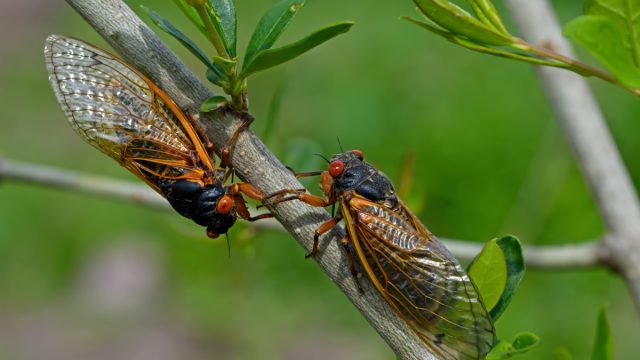Rare Cicada “Double Brood” Will Unleash Swarms in 17 States This Year—Here’s Where

Don’t call it a comeback: Cicadas are making their long-dreaded return to the U.S. in 2024. These insects are not exactly known for making a quiet entrance, and that will be more true than ever this year. In a once-in-a-lifetime event, two different groups (or broods) of cicadas are set to emerge soon: Brood XIII and Brood XIX. Together, this rare cicada “double brood” will unleash swarms in 17 states.
RELATED: “Very Large” New Spider Species Discovered—Here’s Where There May Be Hiding.
The last time two separate broods of periodical cicadas emerged together in the same year was all the way back in 1803, ScienceAlert reported. But the life cycles of both Brood XIII and Brood XIX have managed to line up this year for a rare phenomenon that won’t happen again until 2445.
For the first time in 17 years, Brood XIII is set to emerge in the spring of 2024, according to Cicada Mania. This group of cicadas is predicted to show up in five states: Iowa, Wisconsin, Illinois, Indiana, and Michigan.
Brood XIX is also going to arrive this spring. Cicada Mania says that this will be the first time this species of cicada will have made an appearance in 13 years. These creatures are a bit more widespread and will be found in 14 different states: Alabama, Arkansas, Georgia, Illinois, Indiana, Kentucky, Louisiana, Missouri, Mississippi, North Carolina, Oklahoma, South Carolina, Tennessee, and Virginia.
This means 17 states are likely to be swarmed by millions of cicadas from Brood XIII and XIX when they emerge from the soil to shed their exoskeletons and transform into adults, according to ScienceAlert. (Illinois and Indiana are the unluckiest, since they’ll be hit by both broods.)
As Cicada Mania further explaines, cicadas will start to emerge once the soil eight inches beneath the ground reaches 64 degrees Fahrenheit—which typically occurs from mid-May to late June.
“A nice, warm rain will often trigger an emergence,” Cicada Mania notes.
RELATED: 6 Bugs You Should Never Kill, Pest Experts Warn.
Thankfully, these pests are more of a nuisance than anything else. Cicadas are not actually dangerous, according to the U.S. Environmental Protection Agency (EPA). They don’t bite or sting, and they’re not poisonous or venomous. They even provide some environmental benefits.
The biggest problem for people when it comes to cicadas is the noise that they make. Their distinct buzzing sound can reach 100 decibels, according to the Centers for Disease Control and Prevention (CDC), which is why the insects have earned such heavy complaints over the years.
“It’s a DOUBLE cicada brood breeding year, gang. GET READY FOR A LOUD SUMMER,” one X user wrote.
Another user replied to a tweet about the upcoming phenomenon and said, “The sound of cicadas makes me want to rip my hair out so this already has me stressing because I’m in one of the BAD areas.”
RELATED: For more up-to-date information, sign up for our daily newsletter.